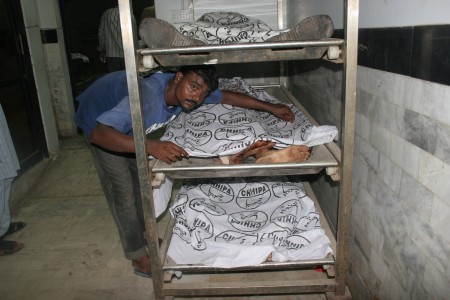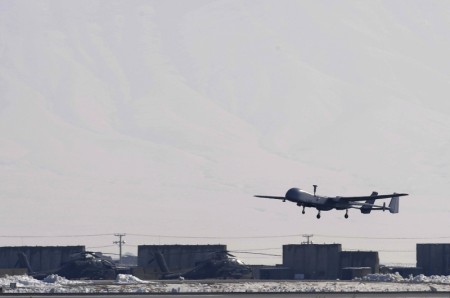Imagine how it is to live in Pakistan; a place where a day without any suicide bombing or drone attack can make the news, where citizens have to deal with emotions such as shock, rage, discomfort and a deep sense of helplessness on a daily basis.
On a recent morning, the first tweet that caught my eye, was one by a Pakistani columnist, Fasi Zaka (@fasi_zaka):
@fasi_zaka: The last moments of a suicide bomber who didn’t die from the blast immediately https://www.facebook.com/video/video.php?v=201156813237903
One of Zaka's Twitter followers’ replied to this tweet:
@Suprah_: The kid is still alive! He is recovering at a local hospital and even did an interview for BBC later http://bbc.in/gFbx1r.

Victims of the explosion at Rummy Club, Karachi are put in a morgue. Image by Syed Yasir Kazmi, copyright Demotix (21/04/2011).
On an average day many Pakistanis re-tweet or share via Facebook news of suicide bombers, NATO drone attacks and the Taliban’s retaliation to them.
Ali Chishti at Pakistanpal's blog writes:
There have been a total of 234 drone attacks in Pakistan since 2004, according to the New America Foundation, including 22 in 2011. The estimated casualties are between 1,439 and 2,290 – of which 1,149 to 1,819 were described as militants in reliable press accounts. [..]
The Pakistani response has been full of confusion and contradictions. The military, after having come to an understanding with the United States in 2006, has allowed limited use of force inside Pakistan because of tough conditions in FATA purely for cost-benefit reasons. At the same time, it has constantly used Pakistani public opinion on the issue to pressure the US.
Acceptance of these drone attacks in Pakistan has made the country's people an unwilling ally. However, regardless of whatever one-sided alliance is created, the people will still suffer, either as a result of the drone attacks or from attacks by the Tehrik-i-Taliban.
Kathy Gannon, a former American correspondent of Afghan-Pakistani affairs during 1986-2005, states something similar in her article published in The Journal Gazette:
Pakistan is frustrated by stepped up drone attacks and accusations it is weak against Islamic militants despite nearly 3,000 dead soldiers, a five-year war in its tribal areas and dozens of arrests of suspected al-Qaida operatives or affiliates.

The Harfang is a reconnaissance drone, guided from a distance by experienced fighter pilots, transport pilots or a navigator. It is used by by the US army in Afghanistan on the Afghan – Pakistan border. Image by DigVID, copyright Demotix (11/03/2010).
In my own blog I have shared opinions of people I have come across, describing how lives in their cities have radically changed out of fear and frustrations.
Fahd Dar, a student from Lahore, says:
Life's going on but it's definitely not the same. People have restricted their outings. Although the famous hang out spots still remain crowded, but the fear of the unknown is still there. With scanning apparatuses installed at almost every corner of the city, even at educational institutes, it naturally gives you a feeling of hesitancy and vulnerability. Lahore doesn't feel that safe now, to eat your favorite eatables late at night, or watch a nifty play at Al-Hamra. Still, our hopes are high, things would get better.
Haris Hameed, a manager at an advertising agency in Islamabad:
A drive from one end of Islamabad to the other meant you had two options. Take the scenic route running parallel to the majestic Margalla Hills or the one that ran through the heart of the business district, fondly dubbed Blue Area. However, that was then. Now, when planning out your route, only one thing is considered: ‘Which route has the least amount of security check posts?’ […]
Understanding that these security measures resembling an obstacle course for mice in a science experiment are a necessity in recent turbulent times, the people of Islamabad have taken everything in their stride. There is always remorse and empathy for victims when there is a bomb blast or terror attack in the city, but with a day or two of caution, the local venture back into their routines. I believe the common thread between the people of the capital (regardless of what section of society they belong to), is that they keep on living. To cower at home in fear and stop leading normal lives is exactly what the terrorists’ want us to do. If we were to do that, it would mean that the terrorists would be successful in their goals, and that they have won. We certainly can’t let that happen. So we live, one day at a time.
We can only hope that soon things will normalize in Pakistan, but hope seems to be far away.







2 comments
Pl. find enclosed this interesting elaboration of events happening in Pakistan